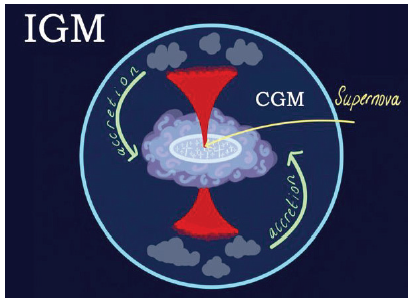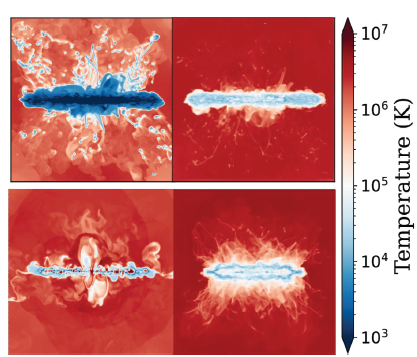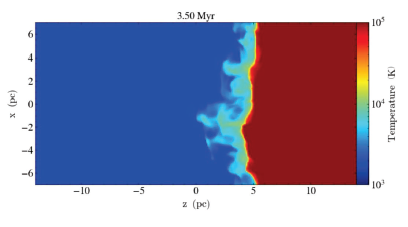ASTROPHYSICS
Galactic Superwinds and the Galactic Baryon Cycle: Cloudy or Foggy?
Principal Investigator:
Dr. Ryan Farber, Dr. Max Grönke
Affiliation:
Department of Physics, Purdue University Fort Wayne, 2101 E. Coliseum Blvd, Fort Wayne, IN 46805, USA, Max-Planck-Institut für Astrophysik, Garching, Germany
Local Project ID:
pn49ye
HPC Platform used:
SuperMUC-NG at LRZ
Date published:
Introduction
On Earth, the water cycle proceeds by three processes. First, water evaporates from the ocean and lakes. Second, water vapor condenses to form clouds. Third, clouds precipitate droplets of water which fall to the Earth as rain. After the rain falls to the Earth, the water droplets collect and eventually flow to lakes and oceans to be evaporated again. Galaxies cycle their star-forming fuel (called “baryons” in distinction to dark matter) in a similar three-step process (see Figure 1).

Figure 1: Cartoon of the galactic baryon cycle. Supernovae in the galaxy launch outflows. Cold clouds in the precipitate onto the galaxy to form new stars.
First, massive stars catastrophically end their lives in explosions, referred to as supernovae. The explosions launch remnant material from the stars into the interstellar and circumgalactic media. Second, gravity congeals the ejected material into clouds. Third, clouds cool, contract, and fragment forming a new generation of stars. Galactic outflows play a crucial role in regulating star-formation in the galactic baryon cycle; otherwise, galaxies would stop forming stars much earlier. The most extreme form of galactic outflow is the superwind, whereby material is launched out of the galaxy. Therefore, superwinds may help to explain the enrichment of metals and magnetic fields in the intergalactic medium. Furthermore, superwinds may extend the star-forming lifetime of galaxies; superwinds may prevent galaxies from rapidly accreting cosmologically pristine gas from the intergalactic medium. Despite the importance of the galactic baryon cycle and superwinds in prolonging the star-forming lifetime of galaxies, the physical mechanism launching star-forming gas into the circumgalactic and inter-galactic medium remains unclear. Moreover, the physical characteristics of the outflows remain to be deter-mined. Originally, work suggested galactic outflows consist of purely hot gas, as supernovae should catastrophically heat any cold clouds during the explosive acceleration process. However, recent work [2] has shown that sufficiently dense cold clouds near the base of the outflows may survive the acceleration, and even grow by cooling any colliding hot gas particles.
Results and Methods
We have explored the physical mechanisms powering galactic superwinds, considering purely thermal, magnetized, and cosmic-ray accelerated superwinds. SuperMUC-NG has allowed us to perform our studies at unprecedented high resolutions from the galactic disk deep into the circumgalactic medium. We have found a shocking dependence on the phase of the medium with respect to the mechanism driving the outflows. Specifically, we utilized the massively parallelized, Eulerian grid-code FLASH [1] to solve the (two-fluid) (magneto-) hydrodynamic equations, evolving Lagrangian tracer particles to identify the fate of star-forming gas in galactic superwinds. We employ FLASH’s unsplit staggered mesh, a finite-volume, high order Godonuv scheme with constrained transport to ensure divergence-free magnetic fields. We include star formation and feedback using active particles, self-gravity of the gas with a multigrid method to solve the Poisson equation, and the Townsend exact integration scheme for radiative cooling. As such, our simulations performed on SuperMUC-NG constitute the physically most sophisticated set of simulations to probe the fate of cold gas clouds deep into the circumgalactic medium to date. As one would expect, magnetized winds are much more filamentary than purely thermal winds. One would expect cosmic rays, which contribute non-thermal pressure support to gas in a similar manner to magnetic fields. Shockingly, we find that superwinds are composed of a much larger number of tiny cold clouds than even the purely thermal winds! Moreover, we find an increasing number of clouds the faster the cosmic rays are transported along magnetic field lines, even though cosmic rays with fast transport significantly reduce the star formation (and hence supernova) rate in galaxies (see Figure 2).

Figure 2: Preliminary results from the Superwind simulations on SuperMUC-NG. Top-left: fast transport cosmic ray simulation (coldest disk and outflows). Top-right: slow transport cosmic ray simulation (much weaker effect). Bottom-left: magnetic fields. Bottom-right: purely thermal (garden-variety galaxy formation simulation).
We have performed follow-up work zooming in for ultra-high resolution to better understand the fate of nonthermally supported clouds. Studying individual clouds in wind-tunnel simulations (see Figure 3), we have found that nonthermally supported clouds survive much more readily than garden-variety thermal plasma, with the survival markedly increased the larger the degree of nonthermal pressure support [3].

Figure 3: Wind-tunnel simulations of individual clouds in hot winds. The top row shows the evolution of a non-thermal pressure dominated cloud, the middle row indicates the evolution for a weakly nonthermal cloud, and the bottom row shows the evolution for a thermal cloud.
Ongoing Research / Outlook
To better understand the results of our superwind simulations, we are presently performing even higher resolution simulations than the wind-tunnel simulations. Namely, we take an individual cloud from the wind-tunnel simulation and zoom in on the interface region to probe the smallest possible scales relevant to our superwind simulations: individual mixing layers. We have found that the clouds outflowing with cosmic rays have cold ~molecular temperatures whereas the thermal winds accelerate predominantly warm atomic clouds. We have found that molecular clouds mix much more efficiently than atomic clouds ([4], Figure 4), providing further understanding of the physical mechanisms supporting enhanced cloud acceleration for the cosmic ray runs than thermal runs in our superwind simulations.

Figure 4: Zoom-in simulation of the interface region of an individual cloud, investigating the mixing rate dependence on cloud temperature. Dark blue indicates cloud material at 1,000 K. Dark red indicates one million Kelvin gas. Intermediate gas around 10,000 K begins to dominate by volume the interface region.
References and Links
[1] B. Fryxell et al., ApJSS, 131, 2000, 273.
[2] M. Gronke, & P. Oh, MNRAS 480, 2018 L111-115.
[3] F. Hidalgo-Pineda, R.J. Farber & M. Gronke, MNRAS 527, 2024, 135-149.
[4] M.G. Blackburn & R.J. Farber, to be submitted to RNAAS.